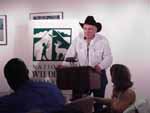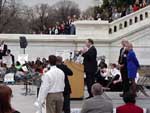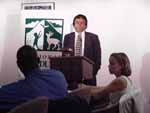March 3, 2000
U.S. Capitol Wildlife Rally Draws Grassroots
& Congressional Support "Bring H.R. 701 To A Vote,"
Urged
See video
footage of the rally!
Select from connection speeds of
28.8K,
56.6K,
or T1.
(Requires RealPlayer™)

Champion "wildlife caller" Ralph Duren voices
howls of support for CARA.

Hundreds of people gathered from all over the
country to support H.R. 701.

NWF President Mark Van Putten, VP Steve Shimberg,
and senior scientist Doug Inkley await the presentation.

House Resources Committee Chairman Don Young
(R-Alaska) is one of the chief sponsors of CARA.

Local children show their support for wildlife.

Representative Don Young address the crowd.

Mark Van Putten rubs elbows with fellow
conservationists.

Conservation groups throughout the country came
to rally for CARA.
|
Congressional leaders from both sides of the aisle joined
grassroots conservation activists and wildlife professionals from
across the nation in Washington, D.C., on March 1, 2000, in a
celebratory rally at the front steps of the U. S. Capitol to
demonstrate support for landmark conservation funding legislation
that is gaining momentum in Congress.
"An historic wildlife and conservation victory is within our
grasp this year in Congress," said Mark Van Putten, President and
CEO of the National Wildlife Federation, one of the rally's main
organizers.
Van Putten lauded Rep. Don Young of Alaska, the Republican Chair
of the House Resources Committee, for his role in crafting H.R. 701, the
Conservation and Reinvestment Act (CARA). The legislation is aimed
at targeting $2.8 billion in annual federal oil and gas leasing
revenue to wildlife management, conservation, coastal protection,
recreation and historic preservation initiatives, mainly at the
state and local level.
"It is time for the Speaker of the House to schedule a vote on
the most historic environmental legislation in a generation," Rep.
George Miller told the crowd. Miller (D-CA), ranking minority member
of the Resources Committee, helped forge the bipartisan alliance
with Rep. Young that has resulted in overwhelming House support for
the bill. "CARA redeems the promise to assure an environmental
legacy for our children and their grandchildren," he said.
CARA
already has 302 co-sponsors in the 435-member House, a
bipartisan majority for major environmental legislation rarely seen
in Congress since the 1970s. Sens. Frank Murkowski (R-AK) and Mary
Landrieu (D-LA) are expected to introduce companion legislation to
H.R. 701 in the Senate soon. The Clinton Administration has offered
its own conservation funding measure in its Lands Legacy Initiative.
The concepts underlying CARA have been endorsed by virtually every
state governor, and hundreds upon hundreds of local and regional
conservation, recreation, sporting and civic organizations
representing million of Americans in all 50 states.
"We urge Speaker of the House Dennis Hastert (R-IL) to heed the
majority and bring the Conservation and Reinvestment Act to a vote,"
Van Putten said. "America's conservation future is at stake."
Van Putten noted the National Wildlife Federation supports
improvements to CARA, including provisions to assure funding for
nongame wildlife, prevent environmentally damaging use of coastal
assistance funding, protect against new incentives for off-shore oil
and gas drilling and eliminate unneeded restrictions on the use of
federal Land and Water Conservation Fund investments.
One of CARA's strongest features is that it will provide
reliable, long-term conservation investments each year through the
year 2015. Under the bill, dedicated funding will be targeted to the
following:
- $1 billion annually for environmental impact assistance and
coastal conservation to 36 coastal states and territories,
including the Great Lakes states.
- $900 million annually divided evenly between state and federal
programs to fully fund the Land and Water Conservation Fund.
- $350 million annually to the states for wildlife conservation
and restoration.
- $125 million annually to the states for urban parks and
recreation.
- $100 million annually for historic site preservation.
- $200 million annually for federal and Indian lands
restoration.
- $150 million annually for conservation easements and
endangered species recovery.
- $200 million annually for payments in lieu of taxes and refuge
revenue sharing.
"The investment opportunities CARA presents are unprecedented in
the annals of conservation legislation," Van Putten said. "With the
proper improvements, this legislation will substantially enhance the
states' ability to manage wildlife, including nongame species. It
provides the resources needed to improve our state and national
park, refuge and recreational lands. It can give communities the
means to begin addressing the problems of urban sprawl and can
provide the largest investment in environmental restoration for our
coastal states in the nation's history."
